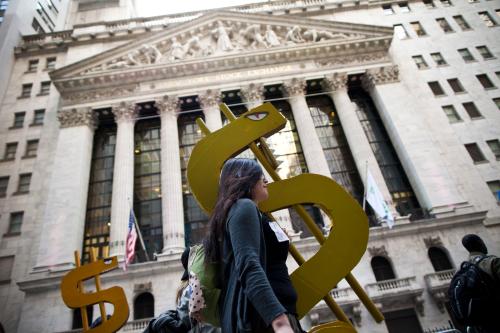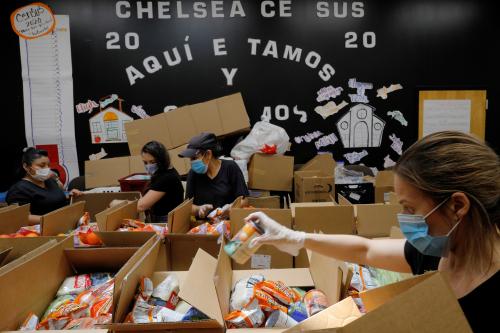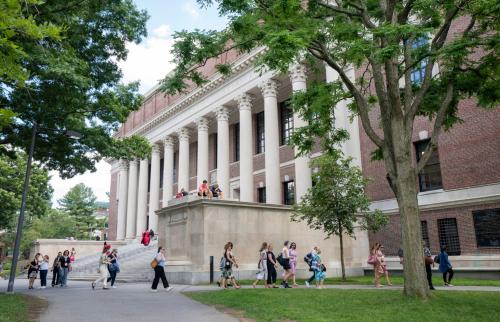On January 20, 2020, the United States reported its first confirmed case of COVID-19. By March 13, New York City had declared a state of emergency. To better understand the influence of COVID-19 on American household finances, the Social Policy Institute at Washington University in St. Louis conducted a nationally representative survey with approximately 5,500 respondents in all 50 states from April 27 to May 12, 2020. Here, we explore the influence that the COVID-19 pandemic has had on student debt, demonstrating the inequities that have let low-income households fall further behind and what this means for these households’ financial outlook. Specifically, we demonstrate (a) how adverse financial circumstances are related to households falling behind on student debt payments; (b) how higher-income households might use relief payments to keep from falling behind on debt payments; and (c) how falling behind on debt payments is related to lower levels of financial well-being (FWB).
Within our sample, roughly one-fourth of households (24 percent) had student loans with an average balance of $30,118 (median amount = $14,750). Of 1,264 households with student loans, roughly one-fourth (23 percent) reported being behind on their student loan payments, and over half of these households (58 percent) reported that they were behind on their student loan payments as a result of COVID-19.
As expected in an epidemic that has shut down large segments of the economy, standard household financial measures, such as employment, income, and liquid assets (amounts in checking accounts, savings accounts, and cash), were significantly related to households falling behind on student loan payments as a result of COVID-19. For example, the proportion of individuals who reported that their households were behind on their student loan payments as a result of COVID-19 was over twice as large among those from low- and moderate-income (LMI) households (18 percent) when compared to those in high- and middle-income (HMI) households (9 percent). Furthermore, the proportion of individuals who reported that their households were behind on student loan payments as a result of COVID-19 was over three times as large among those who lost their job or income due to COVID-19 (26 percent) when compared to those that did not lose their job due or income to COVID-19 (8 percent). Moreover, the proportion of individuals whose households were behind on their student loan payments due to COVID-19 in the bottom liquid assets quartile (29 percent) was almost five times as large as households in the top liquid assets quartile (6 percent).
These findings may seem unsurprising in light of the magnitude of COVID-19’s impact on the economy: According to the U.S. Department of Labor, 33 million individuals collected unemployment benefits the week of June 20. However, these findings appear paradoxical when considering that survey responses were collected after the CARES Act was passed, which placed the majority of student loans on administrative forbearance. Starting March 13, the CARES Act paused most federal student loan payments and set interest rates at 0 percent until September 30, 2020.
Why are some Americans still behind on student loans when the CARES Act granted forbearances?
Although the CARES Act did not cover all loans (e.g., private loans and certain discontinued federal loan programs), most loans not covered in the CARES Act represent only a small proportion (7 percent) of the total dollar amount of student loans. While a large proportion of private loans might explain why such a high number of households in our survey fell behind on their student loan payments as a result of COVID-19, our findings suggest that this explanation likely does not hold. Rather, almost two-thirds (65 percent) of those who report being behind on their student loans as a result of COVID-19 did receive the administrative forbearance (student loan payments deferrals) on their loans from the CARES Act (27 percent did not receive the administrative forbearance, and 7 percent were unsure).
While further research is needed to understand how households perceive “being behind” on their student loan payments, when we look across income, there is evidence for these perceptions: Only 29 percent of LMI households experienced a decrease in their student loan balance compared to 48 percent of high- and middle-income (HMI) households in the three months prior to filling out the survey. Thus, the perception of being behind—when viewed in relative terms—may be quite accurate. Even though many LMI households are not required to make any payments at this time, by not making payments, they are also not moving closer to paying off their loans and enjoying the financial freedom and well-being that come with it. At the same time, many HMI households are moving closer to paying off their loans. Thus, not moving closer to paying off their loans may ultimately mean falling further behind.
Although it is difficult to detect the mechanism that might have led to these inequities in the three months prior to filling out our survey, one plausible explanation is that higher-income households made optional loan payments after the CARES Act was put in place. Furthermore, higher-income households could have used their CARES Act relief payments to pay down their student debts, while lower-income households may have been forced to use these payments for more essential expenses (food, shelter, utilities, etc.). Indeed, we observe that a greater proportion of LMI households used their relief payments for food, rent, and bills (Figure 1).
Figure 1. Households’ use of CARES Act relief payments
 Source: Social Policy Institute COVID-19 Survey
Source: Social Policy Institute COVID-19 Survey
Note: N=2,664
Moreover, when we exclude middle-income households and consider the upper end of the income distribution, we find that over 59 percent of high-income households that received a relief payment prior to taking the survey experienced a decrease in their student loan balance when compared to only 41 percent of high-income households that did not receive a relief payment prior to taking the survey.
Perceptions of being behind on student loans negatively affect financial well-being
Given the pervasive perceptions of “being behind”—even for households who weren’t required to make payments—we were interested in understanding these households’ subjective sense of financial well-being. The Financial Well-Being (FWB) scale was developed by the Consumer Financial Protection Bureau (CFPB) and is defined as the state where a person has control over day-to-day and month-to-month finances; has the capacity to absorb a financial shock; is on track to meet their financial goals; and has the financial freedom to make the choices that allows them to enjoy life.
We find that individuals whose households were behind on their student loan payments as a result of COVID-19 had financial well-being (FWB) scores that were almost 1 standard deviation lower than individuals whose households were not behind on their student loan payments—FWB scores dropping from the 58th percentile to the 21st percentile (Figure 2). Moreover, this significant and substantial difference mostly remained when we accounted for related factors, such as employment, income, liquid assets, student debt amount, and CARES Act student debt and payment relief. Thus, the inability to make progress on paying down student loans may further veer households off track for meeting their financial goals and enjoying the financial freedom that comes with being free of student debt. Even when compared to other individuals that were behind on their student loans, those that were behind due to COVID-19 had significantly and substantially lower levels of FWB. This bleak economic outlook suggests that their ability to get back on track with repayments may be more challenging than other borrowers who are behind yet may not be simultaneously impacted by COVID-19. Thus, while previous research has demonstrated a negative association between student loans and FWB, COVID-19 represents a unique circumstance for student-debt holders, as a lack of job prospects may limit borrowers’ earning potential and, ultimately, alter their repayment plans.
Figure 2. Perceptions of being behind on student loans and financial well-being
 Source: Social Policy Institute COVID-19 Survey
Source: Social Policy Institute COVID-19 Survey
Note: N=1,130
We need better solutions for student debt relief under COVID-19
The CARES Act’s administrative forbearance on federal student loans may be helpful in the short term, as it allows borrowers to pause their payments. However, in the long term, this policy will likely extend the term of these loans, which will in turn, extend the impact of these loans on borrowers. For example, while in the short term being behind in loan payments may manifest itself in lower subjective measures of FWB, in the long term it may manifest itself into more objective measures, such as delayed home-buying and family formation, as well as a larger wealth gap across income groups. Thus, if the effects of COVID-19 are unequally distributed to student debt holders, we must ask ourselves if the relief policies should match this distribution. We believe the answer is yes, and therefore propose a variety of short- and long-term means-tested solutions:
- We suggest another round of cash transfers for LMI households, or a larger amount of cash for LMI households in more widely distributed transfers.
- We also support many of the central tenets of the HEROES Act, which was recently passed by House Democrats. The bill would extend the temporary loan relief through September 2021 and allow for the cancellation of some federal and private student loans (up to $10,000 per borrower). While some have noted the efficiency and effectiveness of universal debt cancellation, we believe that LMI households should receive a larger amount of debt cancellation as a mechanism to fend off rising inequality in the wake of COVID-19.
- Finally, we propose that the federal government make an effort to extend private student loan borrowers and lenders a similar level of relief that federal student loan borrowers received with the CARES Act. This has been done in multiple states thus far and can reasonably be replicated in other states as well.










Commentary
Low-income households falling further behind on student debt due to COVID-19
August 5, 2020